Listen here, fellow A.I.-assisted content writers, you don’t have to feel embarrassed. If you work in online content creation, whether it’s SEO-focused blog posts, web pages, or videos, you’ve likely used an A.I. tool to support you in your endeavors.
Perhaps, you’ve only considered it. Maybe you’ve used one just once to try it out. Or maybe, you’re using one… right now.
Regardless of your experience level, what must be made clear is that these A.I. tools are not all created equally. Some will generate an entire blog post at the click of a button, but require meticulous edits to make it sound less soulless. Others will require you to generate your content section-by-section, which may make this “first draft” take more time, but will likely align a little closer to your intentions when all is said and done.
There’s a lot to look at here, but for this post, I decided to compare three A.I. content generation tools: Jasper, ChatGPT 4.0, and a new up-and-comer, WordCrafter.
How Each A.I. Content Generation Tool Works
We’re not going to get too technical here, talking about the backend processes and such. Instead, I want to focus on how each one of these tools works when it comes to how users prompt them to generate their content. One thing should be noted here; both Jasper and WordCrafter integrate ChatGPT 4.0 into their platforms, but what makes them useful are the “guard rails” they set up for their generated content.
Additionally, for these upcoming examples I am using the same prompt for each tool and comparing their outputs. The topic will be “Credit Card Debt: Tips for College Students.”
Jasper
As a die-hard ChatGPT user, I remember the first time I delved into Jasper’s platform to create a blog post, I was immediately impressed. Before you generate anything, Jasper directs you to their Brand Voice section of their platform to create a specific Voice & Tone that it will follow as closely as it can when generating your content. You can copy/paste text straight into a box, or link a URL for it to read through so it can understand the language and overall “feeling” you want to give you content before you start generating anything. There is also a Knowledge Base section that will allow you to enter in your business or client’s information for Jasper to better understand the purpose this content will serve.

Jasper telling me the Voice & Tone it has gathered from a URL I fed it
From there, you hit the Create Content button and are presented with four options. You may choose from a Blank Document, New Blog Post, New Art, or New from Template (which branches out into a series of other specific options, like Amazon product descriptions or blog post conclusions).

Jasper’s “Create Content” window
For this example, I went with the New blog post option, which allows you to select your previously-generated Tone & Voice and also allows you to select your target audience.
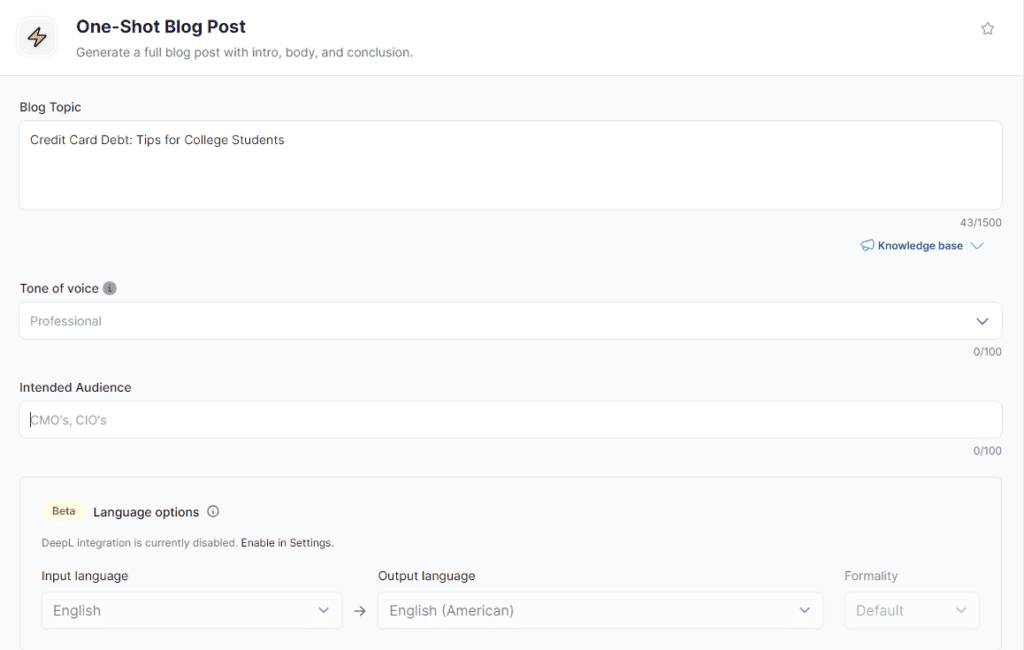
Jasper’s One-Shot Blog Post setup
From here, it’s as simple as hitting the Generate Content button at the bottom of the window, and Jasper will generate the entire blog post in one swoop. You can then re-prompt Jasper on various levels to re-generate the content if you don’t like how it sounds, or if certain sections should be expanded on. I really like the precision here, as it allows you to re-generate entire sections, or you can highlight the text within certain sections to have it re-generate the content if the rest of the section is up to par.
ChatGPT
Tried and true, I frequently use ChatGPT to generate outlines for all sorts of content, from product pages to longform content. However, ChatGPT is a bit more free form in its content generation, meaning you’ll have to set up your own ‘guard rails’ to wrangle in its often boundless approach to writing. Keywords Everywhere has a handful of useful templates just for this purpose, and is a highly useful addon that I recommend to everyone using ChatGPT to generate content. You can also edit-in any additional parameters you want into the text of the Prompt Template it provides:

The Keywords Everywhere prompt template
For this example, I decided to use Keywords Everywhere to generate a Blog Post Outline first, and then subsequently the Generate Complete Blog Post From Outline option. Like the Jasper section, we’re using the same topic, “Credit Card Debt: Tips for College Students.” Let’s take a snippet of what we get for the outline:

A portion of the generated Keywords Everywhere blog outline in ChatGPT
Not bad at all, though I’m not sure if we are speaking to college students who are also pirates with that first header. We’ll move onto the next step; pasting this generated outline into the Generate Complete Blog Post from Outline template:

Copy and pasting the entire outline into the “Blog Post Outline” section of the Keywords Everywhere template
There are obviously plenty of parameters to play with here, such as changing the Voice Tones and Writing Styles, and you can instruct ChatGPT on all of these things without using the Keywords Everywhere template.
So… how’s the output? Well, we’ll talk about that in a bit.
WordCrafter
The new kid on the block, WordCrafter is an A.I. content generation tool that is specifically focused on SEO and is currently under development. To start, you simply choose the keyword or key phrase you want your content to focus on; since we’ve been using a title, we’ll try “credit card debt tips college students” as a phrase and hit Next:
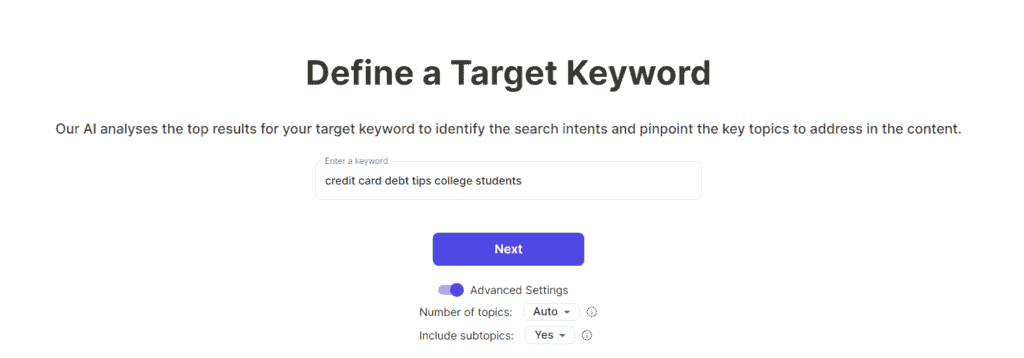
Though not necessarily a high-traffic, thoroughly-researched SEO keyword, this phrase was still enough for WordCrafter to understand the type of content we are looking for. What we get is access to the outline, of which we can edit in or out different headers, edit existing ones, etc.
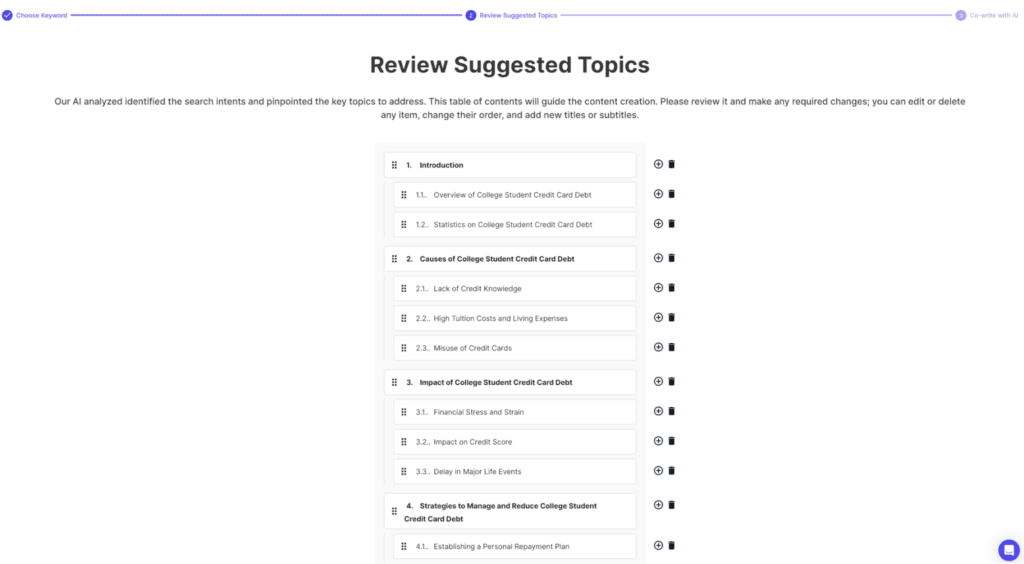
A portion of WordCrafter’s generated outline
From there, you’ll enter another view with an “Input” window to your left, and the outline on the right. You generate each section of body text one at a time, and are able to enter in different instructions within the Prompt section of the input window. This functions very similarly to Jasper; you can rewrite whole sections, highlight text to re-generate specific portions, etc. The biggest difference here is that WordCrafter does not present you with an entire piece but instead forces you to think about and generate each section progressively. You hit a little blue robot face next to each section to start generating the content for each:
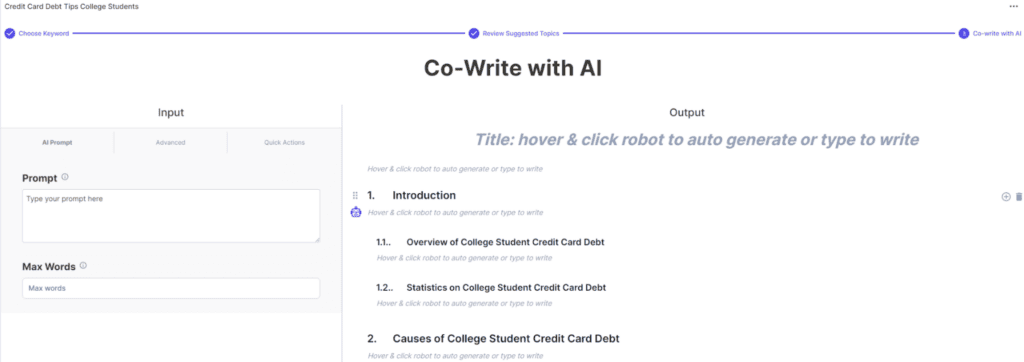
Co-Writing part of the platform on WordCrafter
There are a lot of settings to tweak and play around with in the Input window as well, and all of them have a noticeable effect on the content that’s generated. The entire tone of a section can be changed by simply selecting the “Add more humor” option in the Quick Actions tab, and the Exploratory generation temperature seemingly :

The advanced settings options of the Input window in WordCrafter

The ‘Quick Actions’ tab of the Input window in WordCrafter
The base-generated content is more obvious in its need for edits, but WordCrafter has impressed me with some eloquently-written, human-like passages that have taken me by surprise. It takes a little bit of extra tweaking compared to the other two, but when you find your right set of parameters, WordCrafter generates some good stuff.
Let’s Compare These A.I. Content Generators
Alright, we’re going to go over what each tool does well, what each tool does badly, as well as my transparent opinion on how each tool measures up to the other.
Jasper Pros and Cons
Right off the bat, I’ll say that I think Jasper generated the best “base content” to start editing from. The content it generates generally flows quite logically without sounding too awkward, robotic, or repetitive. I also appreciate that its prompt box follows instructions you feed it very accurately, since at times the other tools may ignore certain parameters you set in your prompts.


An example of Jasper doing exactly what I asked it to, while giving me the option to replace or keep the original content
It also feels like the Voice & Tone and Knowledge Base information has an observable effect on that content generated. The content closely resembles what you provide as an example to follow, and didn’t have any issues as far as having to edit the overall tone of the piece.
Jasper does a great job overall, but it still has its shortcomings. Sometimes it feels like the section-by-section prompting isn’t taking the rest of the piece into context, or is no longer aware of the “flow” of the piece when you as it to re-generate a section.

The opening of this section now reads “In addition to the tips mentioned in this section,” which is a bit illogical since it is a section itself
There are also times where the “veil” of the A.I. seems peeled back, or that Jasper will forget the context in which these prompts are submitted. This has happened a few times, but when I submit a prompt to re-generate a section, sometimes the generated content will respond to my question directly, e.g. “Sure! I can recreate this section with a list for you!” as if I was talking to it in ChatGPT without any of the Jasper guard rails.
ChatGPT Pros and Cons
Ironically, I think one of ChatGPT’s greatest strengths is the lack of limitations that these other platforms give it. The world is your oyster! You are free to set an endless amount of parameters for the content you want generated, and even if you use templates provided by something like Keywords Everywhere, you can edit those or simply use them as ideas for your own prompts.
I find that I got the best outputs from ChatGPT when I made things more conversational; if it does something that I generally like, I complement it and tell it what was correct, but what needs to change, and it generally follows along.

The first few sections of the brief, using the outline generated by Keywords Everywhere

As you can see, it followed along the instructions of my additional prompt pretty concisely
ChatGPT also comes up with some pretty creative H1s and H2s that sound like they were written by a person, and generates an entire piece that seems “aware of its context.” By this I mean that it progresses logically to a wrap-up section or conclusion, without sounding like one big list or anything.
So… let’s get to the bad. ChatGPT suffers from that “A.I. repetition” that most of us in the field know and hate, and it suffers from it more severely than the other two tools. This can range from anything as obvious as using a single word too much, to generating the same sentence structure multiple sections in a row. Sometimes, depending on the topic, it will use overly flowery and dramatic idioms in every section, often reusing phrases like “in the tapestry of musical education” or “through the ebbs and flows of history,” etc.


Examples of ChatGPT generating similar sentence structures a little too close together, even after being asked not to be repetitive
Also, you can make the most elaborate, 2000+ word count prompt that encompasses every possible parameter you desire for you content, and ChatGPT will unfortunately overlook many of the rules you set. It seems very good at grasping 70% of what you want it to do, and creates a decent foundation for longform content, but not without thoroughly going through and editing things to sound more natural.
On top of that, ChatGPT lacks the text-highlighting functionality to re-generate a specific part of a section that Jasper and WordCrafter provide. In fact, you have to ask it a whole ‘nother prompt if you want one section to be generated again, while the other two tools make it much easier. It can capture tone and intent similar to Jasper’s Voice & Tone and Knowledge Base sections, but it’s simply easier to do so on Jasper’s platform than to copy/paste text into ChatGPT.
WordCrafter Pros and Cons
This tool is currently in beta testing. In other words, it’s new, and still under heavy development. That said, WordCrafter can still stand toe-to-toe with these other two tools, showing some very early promise in its content generation capability.
One thing I noticed early on is its inclusion of some real-world statistics with some cited sources, which is something I typically like to include in the content I write.

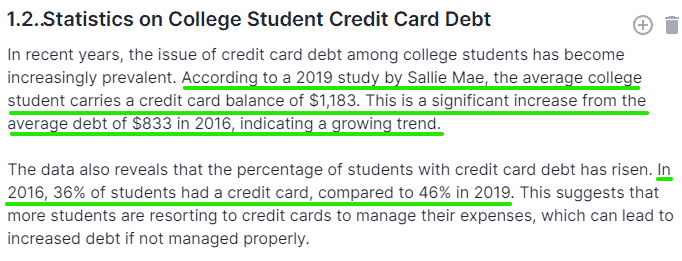
WordCrafter knowing it should include statistics in content like this is a welcome addition
Okay, sure… The statistics are four years old! Regardless, I appreciate the fact that I don’t have to ask WordCrafter to provide numbers; it assumes it should do so, and sometimes past statistics are usable as a reference depending on the writer’s intention. I also like being able to suggest shorter word counts for each section, and watching WordCrafter cut down or expand on the content without losing the main points.
You can also drag-and-drop sections to reorder them, try out different tone’s with a click, or let the A.I. attempt to be more exploratory with its content generation, which can often produce something that sounds similar but just different enough to sound either better or worse, depending on what you’re going for.


As for the bad, I’d like to reiterate that this tool is currently being developed, so a lot of the obvious, more simplistic errors will likely be corrected in time. It suffers from similar repetition issues that are present in ChatGPT, where it will reuse certain words often, and will sometimes open sentences or sections a little too similarly.
On top of that, it doesn’t have an option to generate the entire piece in one go; you can only generate section-by-section. As I mentioned earlier, this can be a plus in the sense that it gives you a better idea of how the piece is flowing, but sometimes you just wanna generate the whole thing to get a broad overview and fix the parts that need to flow better.
The base content that’s generated can also sound a bit too robotic or stale as a starting point. You can generally fix this with some tweaking, but ultimately it does take some more time from you having to generate things section-by-section and messing around with all the different variables.
The Verdict
At the end of the day, I have to give it up to Jasper. The base content it generates and all the different templates and options that are quickly impactful feel really good to use when creating different types of content. I cannot stress enough how accurate and effective the Voice & Tone and Knowledge Base parts of the tool are; I was immediately impressed with how quick and easy it is to set up and the quality of the content it generated.
However, seeing as WordCrafter is developing into a tool seemingly similar to Jasper, it is definitely an up-and-comer to keep an eye on as it currently shows a lot of promise and could potentially be my go-to in the future. It is updated frequently and is catered to those who work in SEO, so it’s definitely worth checking out.

